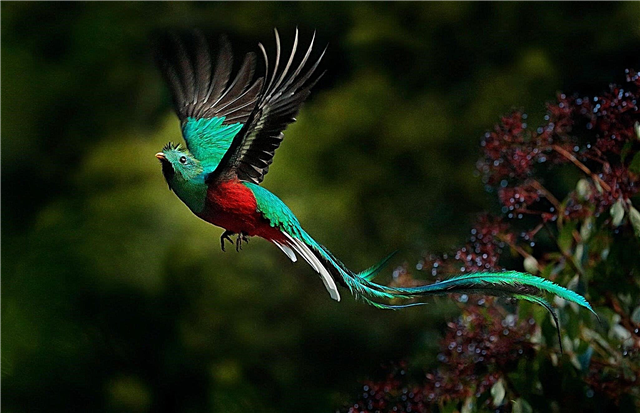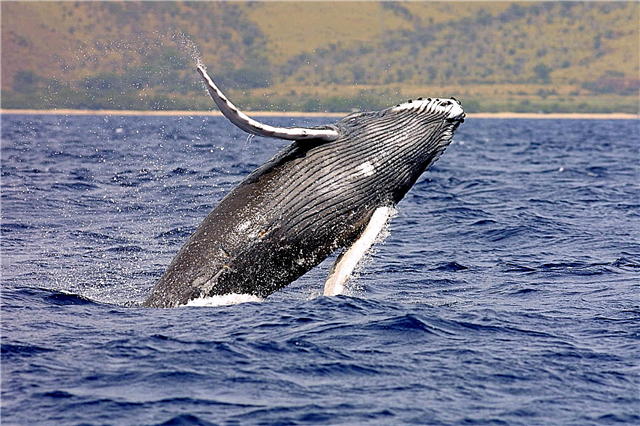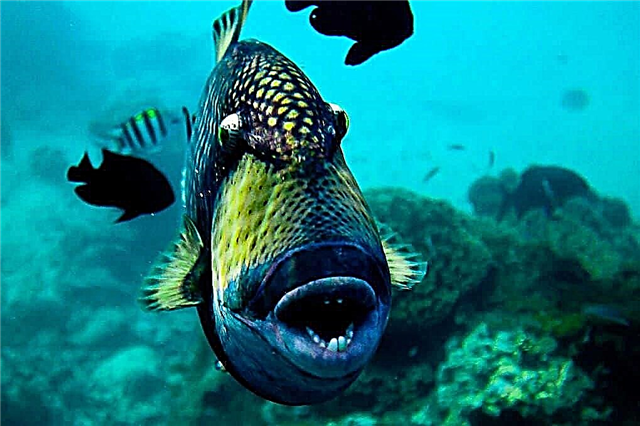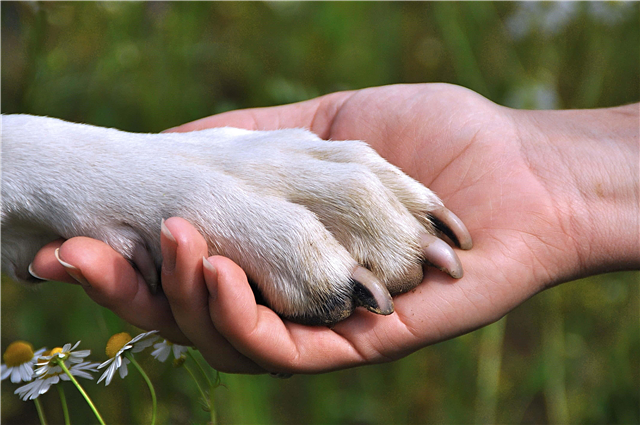
The common hippo, otherwise called the hippo, is a semi-aquatic large mammal. By size, hippos are considered the second largest land animals after elephants living on earth.
Hippo description
Adult individuals are large, grow up to 3.2 tons. With a body length of up to 500 cm along with a tail of 35 cm. The height of the adults at the withers is approximately one and a half meters. The skin color of hippos varies from gray-violet to gray-green. Around the eyes and ears are small pinkish-brown areas. The body of mammals, like that of whales, is almost completely bald. There is no hair on the head and tail, but rare thin thin hairs are located throughout the body.

The outer skin of the hippopotamus is not very thick, so they are vulnerable during labor. Animals completely lack sebaceous and sweat glands. An oily red liquid is released from the mucous membranes, which used to be mistaken for sweat mixed with blood. Now scientists have found that it is a mixture of hipposudoric acid and norhipposudoric. Red sweat protects the hippo's body from harmful ultraviolet light, prevents the development and reproduction of pathogenic bacteria on the body. Initially, the discharge does not have any color, but after several minutes of exposure to the hippo of the sun, they change their color to orange and red.

Despite the apparent clumsiness, hippos are quite maneuverable creatures. They adapted to environmental conditions in such a way that they can easily move both on the surface and in water. On the surface, outwardly clumsy animals can run at a speed of 30 km per hour, running several hundred meters. In shallow areas, short and powerful legs quickly move along the bottom due to the webbed structure of the paws.

The eyes, ears and nostrils of the animal are specially positioned so that the animal can exist most of the time under water, controlling the situation and not suffocating. When a hippo is completely immersed in a pond, it closes its nostrils and ears. Water can no longer get there.

The powerful jaws of the hippos open at an angle of up to 150 degrees. The animal’s mouth has large and sharp fangs and incisors. Fangs can grow up to 50 cm, and the rest of the teeth up to 40. Fangs are constantly sharpened against each other while eating.

The differences between the male and female externally in young individuals are almost imperceptible. Individuals of the stronger sex only weigh 200 kg more than females, which is not so distinguished because of the weight of several tons. However, males grow constantly, while females cease to grow at 25 years old. Throughout their lives, males of hippos grow up to five meters, and females - up to 3.5. The largest male in history weighed 4.5 tons. The jaws of males are more and more developed, the teeth are also larger.
Interesting fact: Hippos can dive holding their breath for up to 10 minutes.
What is the difference between a hippopotamus and a hippo?
The Latin name of the hippos was borrowed from the ancient Greek, in translation from which Hippopotamus means "river horse". Hippos got the name due to the fact that they lived in rivers and made sounds similar to horse neighing. In the CIS countries and Russia, the name "Hippopotamus" was taken, taken from the book of Job and denoting the demon of carnal desires. Thus, the same animal is called two names. Hippopotamus and hippo are one and the same.
Where does the hippo live?

A cloven-hoofed animal lives mainly in water, occasionally coming to the surface for food. Previously, there were many hippos, their population flourished in Africa and Mesopotamia. Before the drought, there were also many of these creatures in the Sahara desert.In ancient Greece, animals also lived in North West Africa, where the states of Morocco and Algeria are now located. In ancient Egypt there were also hippos who lived in the Nile Delta. The complete disappearance of hippos from Egypt dates from the beginning of the 19th century.
Interesting fact: Hippos are considered the most dangerous animals in Africa. They are able to repel any attacks and protect the herd from any threat from the side.
How long does a hippo live?
Scientists believe that hippos can live up to 50 years in captivity and up to 40 years old in the wild. Life expectancy may vary due to the rate of tooth erasure. When an animal has nothing to eat, it dies of hunger.
Habitat

For the most part - shallow water of rivers, swamps, lakes. A hippopotamus completely immerses the body in water, so it needs a depth of two meters. In the afternoon, hippos doze aground or in shallow water. Animals prefer to spend time in groups, enter into mating and give birth in the same shallow water.
If it is impossible to be in shallow water, animals go to the coast for food or plunge to the depths and breathe, leaving only nostrils at the top. Hippos can walk no further than 1.5 km from their river or lake. Walk along a familiar road with plenty of food.
Interesting fact: The animal’s head weighs about 1/4 of the rest of the body.
Range of habitat
At the moment, there are no data on hippo-populated areas. The location of the herd depends on the availability of pasture and ponds. The number of individuals depends on the same indicators. Hippos love to relax in cramped conditions, laying their heads on neighbors.
Hippopotamus breeding

Polygamy is inherent in hippos, which means one male can enter mating games with several females. Matrimonial games do not take place strictly seasonally, but mainly in a small period from the end of winter to August. Cubs are born from mid-spring to mid-spring.
When the time comes for mating games, the males begin to wander around resting places and pastures, carefully sniffing part of the females near the tail. At this time, the males are extremely submissive, they avoid aggression from the whole herd. Such a respectful male is trying to find a female ready for mating games, which he cares for, teases, repels from the herd. When they are left alone, he begins to pursue her until aggression manifests itself in the form of a clash of jaws. The male begins to dominate and enters mating games. The head of the female has been underwater all this time.
If the female does not have enough air, the male still forcibly holds her head under water. This happens until the male makes a hoarse and loud sound that signals completion. Hippopotamus pregnancy lasts almost a year, after which the female gives birth to one cub. At the age of about a year, the baby is weaned from milk, and individuals fully mature by 3.5 years.

Females are extremely aggressive before childbirth, defending themselves against anyone who might be dangerous. For some time they remain isolated on land and return to the herd two weeks after giving birth. Newborn hippos weigh no more than 55 kg. They are strongly attached to their mother, take care of her, just as she cares for them. So they show mutual affection. Cubs have a special ability to eat breast milk under water. Females with cubs are protected by all members of the herd.
Interesting fact: Hippo cubs stand on their feet a few minutes after birth.
Behavior

Animals are highly socialized. Prefer to exist in large groups of up to 100 individuals. Hippos are sedentary. Mostly animals rest, and at night they go to get food. Matriarchy reigns in the herd, females fully control the situation between the members of the herd.
Males are protectors of the family and protect females and children, resting closer to the surface. When males reach the age of seven, the struggle for domination begins.They begin to yawn, roar, fight with other males. Dominant individuals react extremely sharply to any young male who has decided to challenge them. Sometimes they injure rivals or inflict serious injuries that are incompatible with life.

To show who this territory belongs to, males throw themselves with manure, whistle and in every possible way signal their presence. When hippos approach new territories, they mark them. Males regularly come out of the water and mark their habitat.
Territories have to be protected during a drought, when life near the lakes becomes richer than usual. The stronger sex defends its territory, yawning, roaring and snapping its jaws. They manage to discourage even large predators and other males.
Interaction and Signals
Hippos prefer to live in large herds, so they adapted to make a lot of different sounds to communicate with each other. The most common is the signal call of an animal under water. It means that somewhere nearby there was a threat to the herd. The buzz made by an animal reaches a frequency of 115 decibels. This volume is approximately equal to thunder peals.
The signals emitted by the animal are heard in all parts of the reservoir. However, on land hippos can communicate in this way. Individuals can make sounds even when the nostrils are above the water. Around the hippo larynx is a large fat layer that allows you to vocalize over the entire area of the water bodies.
What does a hippo eat?

Hippos get their food at night and at dusk. Graze for 4-5 hours, eat grass shoots, reeds. They can eat other plants if they are located next to them. Large and powerful lips are intended for plucking grass. Food is not chewed by teeth, but simply torn to pieces to prevent tooth loss.
Every day, animals eat about 40 kg of fresh grass, tied to specific pastures. When hippos depart far from the reservoir and do not have time to return, they find another and rest there until the next evening.
Hippos sometimes eat flesh. Previously, these animals were considered herbivores. After long observations, scientists have found that hippos sometimes steal prey from crocodiles and feed on carrion. Hippopotamus is a very dangerous animal. because able to run on land at a speed of 30 km per hour!
Natural enemies of hippos

Such large and formidable animals have practically no enemies. The most dangerous for them are lions and Nile crocodiles. However, one adult can defend itself against several enemies at once and even defeat it.
Females will protect their young from danger until the very end, and the rest of the herd will intervene for them. Hippos become victims of predators only when they are far from their body of water.
Hippos and crocodiles can get along on the same territory, chasing detractors from the shores. Sometimes females entrust their offspring to crocodiles, which protect the cubs from predators. However, it happens that hippos react too aggressively to crocodiles and skirmishes begin.
Predatory animals pose the greatest danger precisely to small hippos. Representatives of another herd may also trample the calf.
Interesting fact: Adult hippos can defend themselves from entire lion prides.
Threats to the mind
There are not many threats to hippos. Predators prefer not to mess with such large animals. Sometimes hippos are attacked by lions or hyenas, less often crocodiles. The biggest threat to hippos is people.
Role in the ecosystem

Massive physique makes animals one of the important links in the ecological system. Since creatures can live both on land and in water, their body becomes the habitat of various living organisms.
During walks to pastures, hippos trample paths in which small fish can hide during rains.Several types of parasites can live on the body of a hippopotamus. On the outer surface of the hippo eye, monogenic worms are attached to the inner part of the membrane, as well as under the eyelids. The eyes of animals do not suffer, but the worms irritate the mucous membrane.
Under the tail of the animal live ticks and leeches. They do not cause serious harm, but the animal may begin to irritate. Flatworms, trematodes are found in the stomach and intestines of animals. Gradually, animals begin to acquire immunity to all parasites in their body.
Security status
The hippopotamus population is constantly decreasing, at the moment there are approximately 130 thousand individuals in their habitats. The main reason for the extinction of animals is poachers. Most often, those animals that inhabit unprotected areas suffer.
Also, animals become smaller due to the disappearance of habitats. Hippos cannot live without freshwater bodies, which is why they are extremely vulnerable to arid conditions, agricultural activities, industry, and changing routes of natural water flows. People take measures to protect and preserve the natural population of hippos. In countries where there are many animals, hunting is prohibited. The natural habitats of animals are carefully protected.
Types of Hippos
At the moment, there are several separate types of hippos. Some of them died out, and the rest exist now.
Common hippopotamus

Ordinary hippos, otherwise called hippos, is one of the species that could survive to our time. Semi-aquatic animals.
Interesting fact: hippos are cunning, have a great ingenuity. They can deceive enemies, dragging them to the bottom.
European hippo

European hippos are a long extinct species that spread in the European part of the world during the Pleistocene period.
Dwarf Cretan Hippo
Another long extinct species is considered to be dwarf Cretan hippos, who lived on the territories of the same island at the same time as the European ones.
Giant hippo

Giant hippos who also lived in the Pleistocene period in the European part of the world. Extinct, were the object of hunting Neanderthals.
Dwarf Maltese Hippopotamus
Then in Malta lived dwarf Maltese hippos, which became small due to the lack of natural aggressors. Dwarf Cypriot hippos inhabited Cyprus even before the start of the Holocene period. Despite being ranked among the dwarf ones, they grew to 200 kg.
Danger to humans

Hippos are herbivores, but don't mind diluting your diet with flesh. They can eat a crocodile or an antelope, graze on farmland, destroying crops. Hippos threaten opponents, yawning widely. Many people consider it touching and do not feel the danger. In fact, if you do not move away from the hippo after such a yawn, then the animal will attack. Animals have large fangs, which can easily tear a living creature. It is by the size of the fangs and the degree of their wear that scientists determine the age of individuals.
Hippos can catch the offender both under water and on land. On the surface, they reach speeds of up to 30 km / h. Many fishermen living near hippo territories are simply left without food. Animals do not allow people to their bodies of water.












